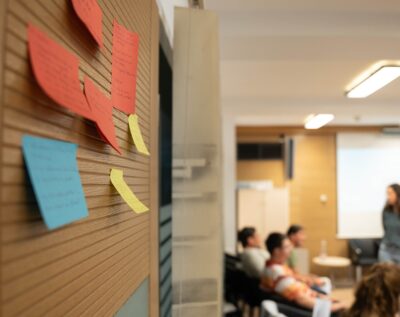Holocaust distortion is a complex and sensitive topic that demands a thoughtful and comprehensive pedagogical approach.
This training curriculum is meticulously developed with a competence-based approach, rooted in the principles of non-formal education, to ensure interactivity, peer learning, open discussions, and reflection.
Competence-Based Approach: The training is designed to develop participants’ competences rather than merely impart knowledge. Understanding Holocaust distortion requires more than factual information; it demands critical thinking, empathy, and a nuanced understanding of historical events. Participants will acquire the competence to analyze, recognize, and counter Holocaust distortion, fostering a deeper engagement with the subject matter.
Non-Formal Education Principles: The curriculum adheres to the principles of non-formal education, recognizing that traditional lecture-style learning may not be the most effective for such a sensitive topic. Non-formal education encourages participatory and experiential learning, ensuring that participants actively engage with the material. Through group activities and case studies, the training creates a dynamic and inclusive learning environment.
Interactivity and Peer Learning: To enhance engagement and foster a sense of shared responsibility, the curriculum emphasizes interactivity and peer learning. Participants are encouraged to collaborate, share perspectives, and learn from each other’s experiences. This approach not only enriches the learning process but also creates a supportive community committed to addressing Holocaust distortion collectively.
Open Discussions and Reflection: Holocaust distortion is a topic that demands open discussions and self-reflection. The curriculum provides a safe space for participants to express their thoughts, ask questions, and critically examine their own biases. Through guided reflection sessions, participants can deepen their understanding of the complexities surrounding Holocaust distortion and its implications.
Addressing the Knowledge Gap: Recognizing that Holocaust distortion is a little-known and under-discussed topic, the training aims to bridge this knowledge gap. Understanding the historical distortion of the Holocaust is crucial for the development of democratic societies. By shedding light on this issue, the curriculum seeks to empower participants with the knowledge needed to contribute to informed discussions and counteract misinformation.
Action-Oriented Approach: The training goes beyond passive learning; it adopts an action-oriented approach. The goal is not merely to inform participants about Holocaust distortion but to instill a sense of responsibility and motivation to take concrete actions. Whether through educational initiatives, community outreach, or advocacy efforts, participants will be encouraged to actively contribute to countering Holocaust distortion in their respective spheres.
Empowering Participants: Participants are not just recipients of information; they are agents of change. The curriculum empowers them to be proactive in their communities, using their newfound knowledge and skills to challenge and confront Holocaust distortion. By fostering a sense of agency, the training aims to create a ripple effect, inspiring participants to become advocates for truth and historical accuracy.
Recommendations for trainers regarding adaptations
Localization
The training is designed taking into consideration the specific background of each target audience. However, further adaptations are needed, according to the specific context in which the training is taking place. The localization of the training is pivotal for ensuring its effectiveness. In the process of localization, particular attention should be paid to:
- Providing relevant examples for the participants. Furnishing pertinent examples is imperative for enhancing participant comprehension. The illustrative content should be tailored to the specific concerns and circumstances of the participants, ensuring that the material resonates with their experiences;
- Focusing on Holocaust distortion both in the country where participants work and in other countries around the world for a more thorough understanding. Recognizing potential reluctance among the audience to confront issues within their own nations, commencing with international examples can facilitate a more receptive mindset;
- Adherence to pedagogical principles. While adapting educational methods to suit the specific context, it is imperative to uphold the foundational pedagogical principles upon which the training is grounded;
- Supporting the participants to develop realistic action plans and motivating them to put them in practice. This approach ensures that the training not only imparts knowledge but also instills a proactive commitment to countering Holocaust distortion.
Accommodating varying time frames
The training has five units. Each unit builds on the competences developed by the participants in the previous units. The order of the educational activities is designed to ensure a meaningful pedagogical flow for the development of knowledge and critical understanding, attitudes, skills and values needed to understand Holocaust distortion and its potential impact on our societies, as well as to contribute to preventing and countering it. Therefore, when working with their participants, the trainers are encouraged to do the entire training. However, should they face time constraints, they can choose to do only certain educational activities. The trainers are encouraged to check the educational activities proposed for all target audiences (some are similar among the target groups, while others are different) and use the ones the find more relevant for their participants. In the process of adaptation, particular attention should be paid to:
- Ensuring a meaningful educational flow that can lead to the development of the competences identified as most needed for that specific group of participants;
- Creating a safe learning space by allowing sufficient time at the beginning (proportional to the duration of the training) for the participants to familiarize with one another and feel at ease expressing their opinions;
- Conducting a comprehensive debriefing process. highly significant as it enhances learning outcomes, facilitates deeper understanding, and enables participants to make connections between different topics, consolidating the newly developed competences;
- Compiling a list of resources for participants (texts, videos, museums to visit, other training sessions they can attend, etc.). The curriculum for individual learning on this website can be valuable for this purpose.
